软件设计与体系结构-齐治昌
- 格式:ppt
- 大小:11.47 MB
- 文档页数:665
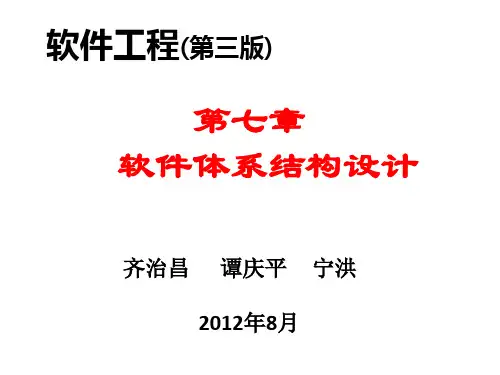
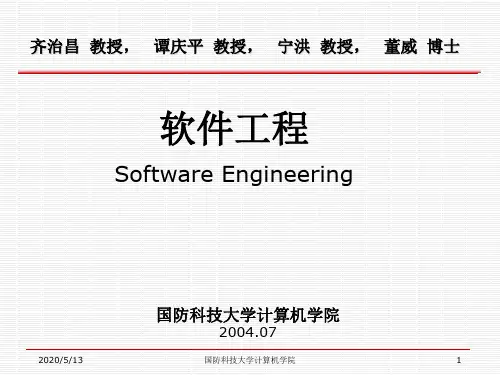
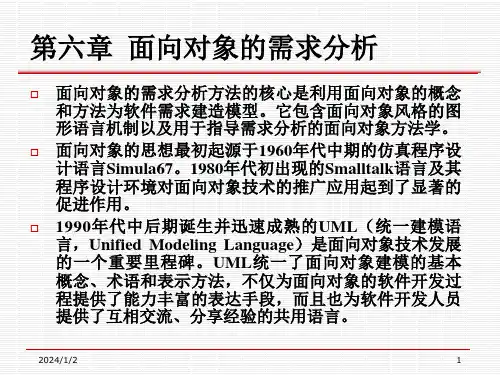

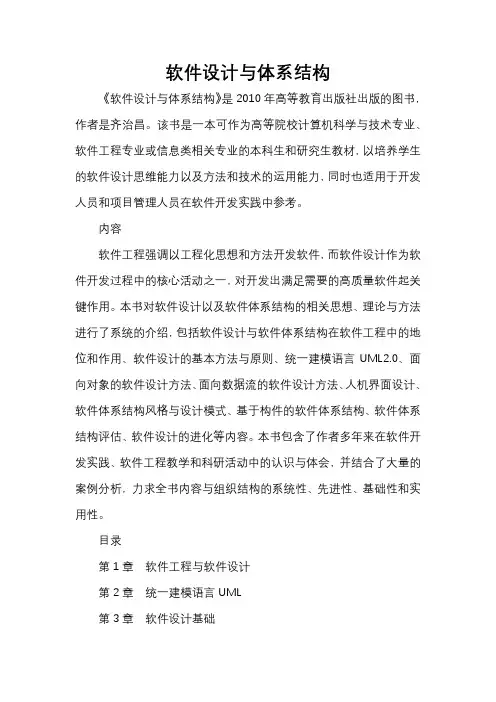
软件设计与体系结构《软件设计与体系结构》是2010年高等教育出版社出版的图书,作者是齐治昌。
该书是一本可作为高等院校计算机科学与技术专业、软件工程专业或信息类相关专业的本科生和研究生教材,以培养学生的软件设计思维能力以及方法和技术的运用能力,同时也适用于开发人员和项目管理人员在软件开发实践中参考。
内容软件工程强调以工程化思想和方法开发软件,而软件设计作为软件开发过程中的核心活动之一,对开发出满足需要的高质量软件起关键作用。
本书对软件设计以及软件体系结构的相关思想、理论与方法进行了系统的介绍,包括软件设计与软件体系结构在软件工程中的地位和作用、软件设计的基本方法与原则、统一建模语言UML2.0、面向对象的软件设计方法、面向数据流的软件设计方法、人机界面设计、软件体系结构风格与设计模式、基于构件的软件体系结构、软件体系结构评估、软件设计的进化等内容。
本书包含了作者多年来在软件开发实践、软件工程教学和科研活动中的认识与体会,并结合了大量的案例分析,力求全书内容与组织结构的系统性、先进性、基础性和实用性。
目录第1章软件工程与软件设计第2章统一建模语言UML第3章软件设计基础第4章面向对象的软件设计方法第5章面向数据流的软件设计方法第6章用户界面设计第7章软件体系结构风格与设计模式第8章基于分布构件的体系结构第9章软件体系结构评估第10章软件设计的进化“软件设计与体系结构”课程是为软件工程专业开设的必修课,也是计算机科学与技术软件开发方向课程。
本课程运用工程的思想、原理、技术、工具,来对软件设计以及软件体系结构的相关思想、理论与方法进行系统介绍,包括软件模型和描述、软件体系结构建模和UML、软件设计过程、软件体系结构风格、面向对象的软件设计方法、面向数据流的软件设计方法、用户界面设计、设计模式、Web服务体系结构、基于分布构件的体系结构、软件体系结构评估、软件设计的进化、云计算的体系结构等内容。
本课程的具体任务包括:1.让学生建立构建软件系统架构一般方法的感性认识,理解并掌握软件系统架构分析、体系结构建模与架构设计的相关理论知识,培养学生软件架构设计的基本能力,能从内部模块规划设计、系统层次结构的构建开始,了解构建系统结构的一般技术和方法。
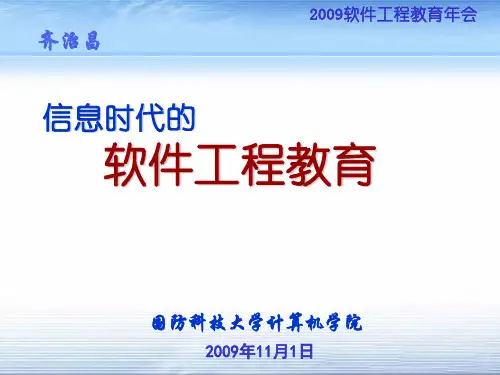
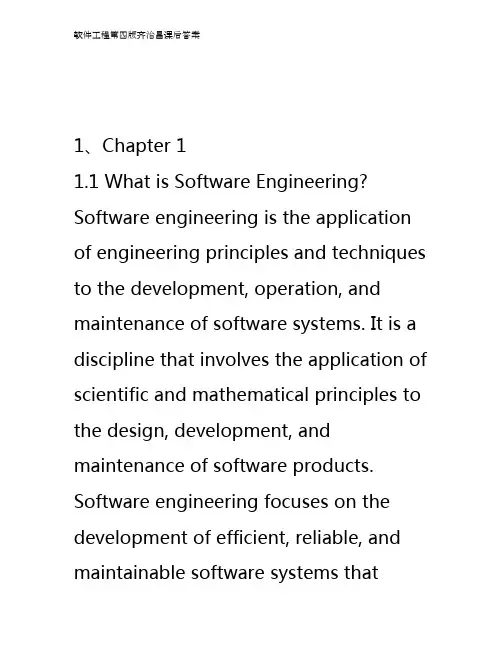
1、Chapter 11.1 What is Software Engineering? Software engineering is the application of engineering principles and techniques to the development, operation, and maintenance of software systems. It is a discipline that involves the application of scientific and mathematical principles to the design, development, and maintenance of software products. Software engineering focuses on the development of efficient, reliable, and maintainable software systems thatmeet the needs of their users.1.2 What is the Software Life Cycle? The software life cycle is the set of stages that a software product goes through from its conception to its retirement. It typically consists of the following stages: Requirements Analysis, Design, Implementation, Testing, Deployment, Maintenance, and Retirement. Requirements Analysis involves gathering information from stakeholders and users to determine the needs of the software. Design involves creating a plan for the software thatmeets the requirements identified during Requirements Analysis. Implementation involves coding the software according to the plan created during Design. Testing involves verifying that the software works as expected. Deployment involves making the software available to its users. Maintenance involves making changes to the software to fix any bugs or to add new features. Retirement involves removing the software from use and archiving any important data or documents associated with it.1.3 What is the Difference Between Software Engineering and Computer Science?Software engineering and computer science are related disciplines, but they are not the same. Software engineering focuses on the development of software products, while computer science focuses on the study of computers and computing. Software engineering involves the design, development, and maintenance of software systems, while computer science involves the study of algorithms, data structures, and programming languages. Softwareengineering focuses on the practical application of engineering principles and techniques to the development of software products, while computer science focuses on the theoretical aspects of computing.2、Chapter 22.1 What is the System Development Life Cycle?The system development life cycle (SDLC) is a process used by software engineers to develop software products. The SDLC consists of six stages: planning, analysis, design, implementation, testing, andmaintenance. During the planning stage, the software engineer collects information from stakeholders and users to determine the scope and requirements of the software product. During the analysis stage, the software engineer analyzes the gathered information to determine the user’s needs and the software’s requirements. During the design stage, the software engineer creates a plan for the software product. During the implementation stage, the software engineer codes the software according to the plan created during the design stage. During thetesting stage, the software engineer verifies that the software works as expected. During the maintenance stage, the software engineer makes changes to the software to fix any bugs or to add new features.2.2 What is the Waterfall Model?The waterfall model is a software development process that follows a linear approach. It is a sequential process where each stage must be completed before the next stage can begin. The stages of the waterfall model are: requirements analysis, design,implementation, testing, deployment, and maintenance. During the requirements analysis stage, the software engineer collects information from stakeholders and users to determine the scope and requirements of the software product. During the design stage, the software engineer creates a plan for the software product. During the implementation stage, the software engineer codes the software according to the plan created during the design stage. During the testing stage, the software engineer verifies that the software works as expected. During thedeployment stage, the software engineer makes the software available to its users. During the maintenance stage, the software engineer makes changes to the software to fix any bugs or to add new features.2.3 What is the Spiral Model?The spiral model is a software development process that follows a cyclical approach. It is an iterative process where each stage is repeated multiple times until the desired result is achieved. The stages of the spiral model are: requirements analysis, design,implementation, testing, deployment, and maintenance. During the requirements analysis stage, the software engineer collects information from stakeholders and users to determine the scope and requirements of the software product. During the design stage, the software engineer creates a plan for the software product. During the implementation stage, the software engineer codes the software according to the plan created during the design stage. During the testing stage, the software engineer verifies that the software works as expected. During the软件工程第四版齐治昌课后答案deployment stage, the software engineer makes the software available to its users. During the maintenance stage, the software engineer makes changes to the software to fix any bugs or to add new features. The spiral model allows the software engineer to quickly make changes and adjustments to the software product as needed.。

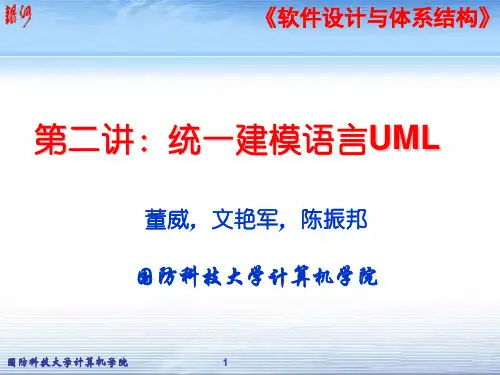
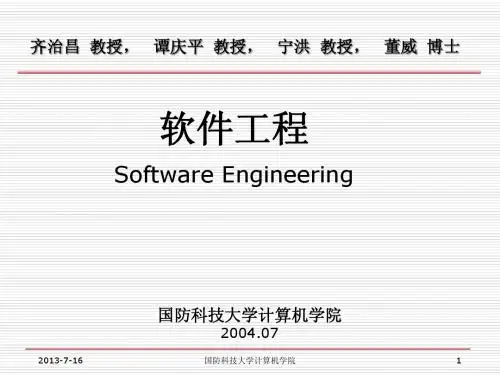
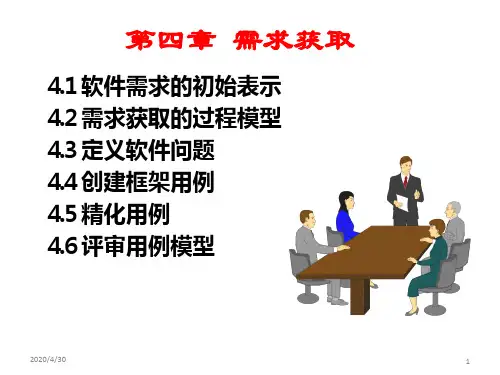
软件工程齐志昌版第一点:软件工程的定义与发展软件工程是一门研究如何系统地设计、开发、测试和维护软件的应用学科。
它旨在通过工程化的方法,提高软件的质量、提高开发效率、降低开发成本。
软件工程的概念最早可以追溯到20世纪60年代,当时计算机科学家们开始意识到,软件开发需要像传统工程领域一样,采用科学的方法和规范的流程,以确保软件的可靠性和稳定性。
随着计算机技术的不断进步和软件规模的不断扩大,软件工程逐渐发展出了多个分支领域,如软件架构、软件需求工程、软件测试、软件项目管理等。
同时,软件工程也不断吸收和融合其他学科的理论和技术,如心理学、社会学、经济学等,以更好地适应人类社会的发展需求。
在软件工程的发展过程中,涌现出了许多重要的方法和理论,如结构化分析、面向对象设计、敏捷开发等。
这些方法和理论为软件开发提供了有力的指导,使得软件工程成为了一门具有广泛应用和深远影响的学科。
第二点:软件工程的关键技术和方法软件工程的关键技术和方法是保证软件质量、提高开发效率的基础。
以下是几种常见的软件工程技术和方法:1.结构化分析:结构化分析是一种用于需求分析和系统设计的软件工程方法。
它通过建立数据流图、实体关系图等模型,来描述系统的功能和数据结构。
结构化分析有助于明确系统的需求,为后续的软件开发提供清晰的指导。
2.面向对象设计:面向对象设计是一种基于对象、类和继承等概念的软件设计方法。
它将现实世界中的事物抽象为对象,并通过对象之间的交互来实现系统的功能。
面向对象设计有助于提高软件的可重用性、可维护性和可扩展性。
3.敏捷开发:敏捷开发是一种注重快速响应变化、强调团队协作和持续改进的软件开发方法。
它通过短周期的迭代开发、持续反馈和适应性规划,来提高软件开发的灵活性和适应性。
敏捷开发适用于快速变化的软件需求和复杂的项目管理。
4.软件测试:软件测试是确保软件质量的重要环节。
它包括单元测试、集成测试、系统测试和验收测试等多种测试类型。
软件工程-齐志昌版 (3)软件工程-齐志昌版 (3)1. 引言本文档是软件工程课程的第三篇文档,旨在介绍软件工程的一些基础知识和概念。
软件工程是一个涵盖软件开发全过程的学科,旨在提高软件开发的效率、质量和可维护性。
在本文档中,我们将介绍软件工程的重要性、软件生命周期、软件开发方法和软件开发团队的组织结构。
2. 软件工程的重要性软件工程在现代社会中变得越来越重要。
随着互联网和移动应用的普及,软件已经成为人们日常生活和工作中不可或缺的一部分。
良好的软件开发过程可以提高软件的质量,减少错误和缺陷的数量,并提高软件的可维护性和可扩展性。
软件工程的实践可以帮助开发团队有效地规划、设计、开发、测试和交付高质量的软件产品。
3. 软件生命周期软件生命周期包括需求分析、设计、编码、测试和维护等阶段。
每个阶段都有特定的目标和活动,旨在确保软件开发过程的高效性和质量。
软件工程师需要在每个阶段采用适当的工具和技术,严格遵循软件工程的规范和最佳实践。
3.1 需求分析阶段需求分析阶段是软件开发过程的第一阶段,其目标是收集、分析和明确系统的功能和性能需求。
在这个阶段,软件工程师通常与客户合作,使用一些需求工程的技术和方法。
需求分析的输出结果是软件需求规格说明书,它包含了对系统需求的详细描述和功能规划。
3.2 设计阶段设计阶段是根据需求分析的结果,进行系统的设计和架构的阶段。
在设计阶段,软件工程师使用各种建模工具和技术,如UML (统一建模语言),来描述系统的逻辑结构和组件之间的交互。
输出结果是系统的设计文档,它描述了系统的整体架构和关键模块的设计。
3.3 编码阶段编码阶段是将设计文档转化为实际可执行的代码的阶段。
软件工程师使用程序设计语言,如Java、C++、Python等,根据设计文档编写代码。
在编码阶段,需要注意代码的可读性、可维护性和可测试性。
3.4 测试阶段测试阶段旨在验证软件的质量和功能正确性。
在这个阶段,软件工程师使用各种测试技术和工具,如单元测试、集成测试和系统测试,来检测和修复软件中的错误和缺陷。